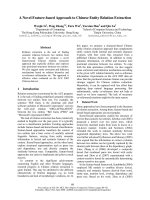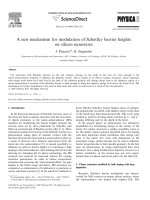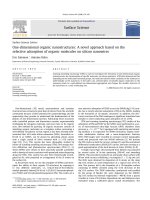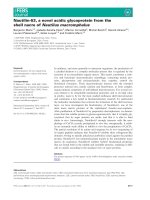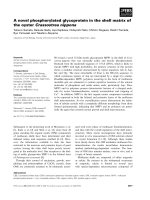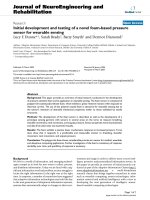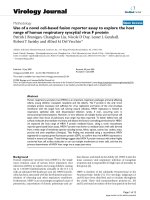- Trang chủ >>
- Khoa Học Tự Nhiên >>
- Vật lý
One dimensional organic nanostructures a novel approach based on the selective adsorption of organic molecules on silicon nanowires
Bạn đang xem bản rút gọn của tài liệu. Xem và tải ngay bản đầy đủ của tài liệu tại đây (1.97 MB, 5 trang )
Surface Science Letters
One-dimensional organic nanostructures: A novel approach based on the
selective adsorption of organic molecules on silicon nanowires
Eric Salomon
*
, Antoine Kahn
Department of Electrical Engineering, Princeton University, E-quad, Olden Street, Princeton, NJ 08544, United States
article info
Article history:
Received 11 March 2008
Accepted for publication 16 April 2008
Available online 26 April 2008
Keywords:
Chemisorption
Nanopatterning
Scanning tunneling microscopy
Scanning tunneling spectroscopy
abstract
Scanning tunneling microscopy (STM) is used to investigate the formation of one-dimensional organic
nanostructures by chemisorption of specific molecules on silicon nanowires. STM data demonstrate that
depending on the molecular functional groups, the molecules adsorb either randomly on the substrate or
preferentially on the nanowires. In the latter case, chemisorption of suitable organic molecules on the
nanowires leads to a well-defined one-dimensional aggregation and changes the metallic character of
the nanowires to a semi-conducting one.
Ó 2008 Elsevier B.V. All rights reserved.
One-dimensional (1D) metal, semiconductor and insulator
structures have attracted a great deal of interest from the scientific
community because of their potential for nanotechnology and the
opportunity they provide to understand the fundamentals of the
physics of low-dimensional systems. Fabricating these structures
with controlled pattern and dimensions remains experimentally
challenging for inorganic materials, and even more so for organic
ones. One method for growing 1D organic structures consists of
adsorbing organic molecules on a template surface presenting a
well-defined 1D-pattern. In that regard, it has been recently dem-
onstrated that 16 Å wide silicon nanowires (NWs), heretofore re-
ferred to as SiNWs, can be grown by adsorbing silicon atoms
onto a single crystal of silver oriented with a (110) surface
(Ag(110)) [1,2]. This system has been thoroughly studied by
means of scanning tunneling microscopy (STM), low energy elec-
tron diffraction and photoelectron spectroscopies (PESs) [1–3].
These SiNWs were shown to form massively parallel assemblies
with a density of states consistent with quantized states dispersing
along the NWs. This system has also been theoretically investi-
gated by He, who proposed an arrangement of the Si atoms on
the surface [4].
In the present work, we use this template of SiNWs and inves-
tigate the ability to form organic 1D-structures by exposing it
to two different molecules, i.e., tris{2,5-bis(3,5-bis-trifluoro-
methyl-phenyhl)-thieno}[3,4-b,h,n]-1,4,5,8,9,12-hexaazatriphenyl-
ene (THAP) and 9,10-phenanthrenequinone (PQ). The results are a
non-selective adsorption of THAP across the SiNWs/Ag(110) sam-
ple, but a clearly selective adsorption of PQ on the SiNWs, leading
to the formation of 1D organic structures. In addition, the elec-
tronic structure of the NWs undergoes a significant transition from
metallic to semi-conducting upon adsorption of 4 L of PQ.
STM and scanning tunneling spectroscopy (STS) studies of the
adsorption of PQ and THAP on the SiNWs were performed in a ser-
ies of interconnected ultra-high vacuum (UHV) chambers (base
pressure p $ 5 Â 10
À11
Torr) equipped with sputtering and anneal-
ing facilities, a Si evaporator for SiNWs formation, organic mole-
cules sublimation stations and a room-temperature Omicron
STM. STM images were recorded in constant current topographic
mode and processed with the WSxM software [5]. We present
the STS results as both the current–voltage I(V) and the normalized
differential conductance (dI/dV)/(I/V) curves, the latter serving as a
good approximation of the local density of states (LDOSs) [6–8].
A single crystal Ag(110) purchased from Mateck was prepared
by several cycles of Ar-ion sputtering (500 eV) and annealing
(690 K). This procedure produced an atomically clean surface with
80 nm wide terraces exhibiting a rectangular (1 Â 1) Ag unit cell.
The NWs were obtained by deposition of Si atoms on the clean
Ag(110) surface at room-temperature at a typical rate of 0.7 Å/
min. This process led to the formation of a 1D-template surface
consisting of SiNWs oriented along the ½
110 direction of the
Ag(110) surface. The THAP molecules, synthesized and purified
by the group of Marder [9], were deposited on the SiNWs/
Ag(110) surface by thermal evaporation ($480 K) from a quartz
crucible at a rate of 0.5 Å/min. Deposition rate and thickness were
estimated using a calibrated quartz crystal microbalance. The
0039-6028/$ - see front matter Ó 2008 Elsevier B.V. All rights reserved.
doi:10.1016/j.susc.2008.04.023
* Corresponding author. Tel.: +1 609 258 3582; fax: +1 609 258 6279.
E-mail address: (E. Salomon).
Surface Science 602 (2008) L79–L83
Contents lists available at ScienceDirect
Surface Science
journal homepage: www.elsevier.com/locate/susc
THAP source was well out-gassed prior experiment and has been
used several times for evaporation on various surfaces resulting
in the formation of very nice, clean and well characterized THAP
monolayers [10,11]. The PQ molecules, purchased from Sigma–Al-
drich, were loaded under nitrogen atmosphere in a glass ampoule
connected to a UHV leak valve. This setup was then mounted on
the UHV system connected to the growth chamber. The exposure
of the sample to PQ was estimated via the background pressure
of molecules monitored with an ion gauge. The PQ exposure is gi-
ven in Langmuir (1 L = 1.10
À6
Torr s).
Fig. 1a and b displays two STM images of the 1D-template sur-
face, which consists of multiple SiNWs adsorbed on Ag(110). The
observed SiNWs are aligned along the ½
110 direction of the Ag sur-
face and present identical characteristic width of 15 ± 1 Å. The
structural and electronic properties of these SiNW structures have
been thoroughly investigated by STM and PES [1–3]. However, to
date no experimental data of the LDOSs had been reported. The
dotted red curve in Fig. 2
1
shows the normalized differential con-
ductance (dI/dV)/(I/V) obtained by STS on the SiNWs. The zero on
the bias axis corresponds to the Fermi level (E
F
). With negative
and positive voltages applied to the sample, STS probes the local
density of occupied and unoccupied states of the sample, respec-
tively. The data exhibit two clear peaks located at À0.89 V and
+1.82 V. These features correspond to two electronic quantum states
presumably due to the confinement of electrons inside the SiNWs.
The peak at À0.89 V is in good agreement with the first discrete state
previously observed by PES at a binding energy of 0.92 eV with re-
spect to E
F
[1]. A comparison of the STS data with DFT calculations
shows that the observed LDOS is mainly due to the Si3p orbitals of
the silicon atoms [4]. In addition, a non-zero LDOS is observed in
the proximity (À2 eV to +2 eV) of E
F
. This non-zero LDOS, as well
as the monotonic increase in current with bias (inset of Fig. 2), sug-
gest that the SiNWs present a metallic character. This supports the
observation made by Leandri et al. based on a detailed analysis of
the Si2p core levels and valence band of the surface [1].
To address the issue of whether or not any type of molecule will
react exclusively with the SiNWs, we used two different types of
molecules. For the control experiment, a molecule (THAP) with
no particular functional group that could specifically react with
the SiNWs was chosen. Subsequently, a molecule (PQ) with a dicar-
bonyl group, for which a strong and preferential reaction with the
SiNWs is expected, was selected. The THAP molecule has been
thoroughly studied in our group by means of PES and STM. Its
adsorption on a clean Ag(110) substrate was characterized by
STM [10], allowing us to compare it to the adsorption on the SiNWs
modified Ag(110) surface.
Two filled states STM images of the surface following the evap-
oration of 4 Å of THAP are displayed in Fig. 3a and b. Each molecule
appears as a six-pronged shape with six bright lobes and a dark
center. The six-pronged shape is different from the shape usually
observed for ordered layers of THAP adsorbed on Ag(110) or
Au(111), where each molecule presents three bright lobes
[10,11]. The discrepancy could be due to a different molecule–sub-
strate interaction or to the fact that STM gives an average image of
a molecule freely rotating at room-temperature between two
equivalent positions. Tip effects cannot be discounted either. How-
ever, regardless of the appearance of the molecule, the STM micro-
graphs clearly show that the molecules are randomly adsorbed on
the surface, some on top on the SiNWs and some in between two
SiNWs. This non-selective behavior suggests that no specific inter-
action takes place between the molecules and the SiNWs. In addi-
tion, the THAP adsorbed on the clean Ag areas are not ordered
according to the same structure as that observed upon adsorption
on a clean Ag(110) surface [10]. The reactivity of the Ag surface is
presumably locally modified by the SiNWs, possibly by the forma-
tion a 2D surface Si–Ag alloy, as in the case of Si adsorbed on
Cu(110) [12]. Furthermore, the long-range point-on-line coinci-
dence observed between the THAP and Ag lattices on the THAP-
on-clean-metal surface [10] , which is believed to be at the origin
of the molecular ordering, cannot develop here between closely
spaced SiNWs. Measurements performed one day after the evapo-
ration of THAP on the surface exhibit the same random adsorption
of the THAP molecules on the surface. This suggests that even after
a significant amount of time for diffusion of THAP molecules is gi-
ven, the adsorption remains non preferential.
Having established that no preferential adsorption of THAP on
the SiNWs is observed, we proceeded by exposing the SiNWs/
Ag(110) surface to 1 L of PQ, the result of which is shown in
Fig. 4a. Two different types of structures are observed: bright pro-
trusions, which are attributed to aggregates of PQ molecules, and
faint lines, which correspond to the SiNWs. The faintness of the
SiNWs, as compared to Fig. 1, is due to the presence of the molec-
ular aggregates on top of the SiNWs which decreases the contrast
between the SiNWs and the Ag surface. The molecular aggregates
form discontinuous lines oriented along the ½
110 direction of the
Ag that corresponds to the direction of the SiNWs. Furthermore,
from this image one can notice that the molecular aggregates are
exclusively adsorbed on top of the SiNWs. This observation is even
clearer on the bottom right inset image. For this exposure, no
molecular aggregate can be observed in between two SiNWs,
clearly demonstrating a highly selective reaction between the PQ
molecules and the SiNWs. As the exposure to PQ increases up to
4L(Fig. 4b), the 1D alignment and the selective adsorption of the
organic structure are preserved, confirming that the first step in
the adsorption process of the PQ on the SiNWs/Ag(110) surface
is the specific interaction with the SiNWs.
We propose that the selective adsorption of PQ molecules on
the SiNWs occurs via chemical reaction. In order to describe the
adsorption mechanism, we refer to the structural model of an indi-
vidual SiNW proposed by Sahaf et al. [2]. According to this model,
the top layer of the NWs consists of Si dimers (Fig. 5a). Following
the experimental work done by Fang et al. and Hacker et al.
[13,14] as well as the first principle calculations performed by Her-
mann et al. [15] on the adsorption of PQ on Si(001), we propose
that an interaction occurs here between the Si dimers and the
dicarbonyl group of the molecule via a specific chemical reaction
so-called [4 + 2] cycloaddition. Such a reaction has been previously
observed and well described between molecules containing a
dicarbonyl or diene functions and Si surface dimers [16–20]. This
process is depicted in Fig. 5b and results in the formation of cova-
Fig. 1. (a) Chemical structure of the THAP molecule and R stands for a trifluoro-
methyl group (–CF
3
). (b) Chemical structure of the PQ molecule.
1
For interpretation of color in Figs. 2–6, the reader is referred to the web version of
this article.
L80 E. Salomon, A. Kahn / Surface Science 602 (2008) L79–L83
SURFACE SCIENCE
LETTERS
lent bonds between the top silicon atoms of the NWs and the oxy-
gen atoms of the molecules. These bonds are particularly interest-
ing because they provide strong connectivity between the organic
compound and the inorganic substrate (see Fig. 6).
The electronic properties of the 1D organic nanowires (ONWs)
obtained upon exposure of the SiNWs to 4 L of PQ are investigated
via STS. Fig. 2 displays the normalized differential conductance re-
corded on the pristine SiNWs (dotted red curve) and on the ONWs
(full blue curve). We also have superimposed the LDOS measured
in-between the SiNWs (black open circle curve) in order to show
that the LDOS of the SiNWs is distinct from that of the Ag(110)
nearby. Data carried out of both the SiNWs and the ONWs present
significant changes. First, the current measured on the ONWs is
substantially lower than that measured on the SiNWs, as expected
from the relatively low conductivity of the organic molecules. Sec-
ond, as inferred from both the I(V) (inset of Fig. 2) and (dI/dV)/(I/V)
curves, the ONWs do not exhibit a metallic character. The plateau
observed in the I(V) curve is clear evidence of the semi-conducting
nature of the ONWs. The 0.3 eV gap observed in the (dI/dV)/(I/V)
curve is consistent with the semi-conducting character of the
ONWs, even though the gap appears smaller than expected for
the PQ molecule ($2 eV for an isolated molecule [15]). Since the
thickness of the ONWs is of the order of several ångström, the
observed LDOS is a convolution of the LDOS of the SiNWs and that
of the adsorbed PQ aggregates. Therefore, the contribution of the
LDOS of the SiNWs at the proximity of the Fermi level is presumably
Fig. 2. STM filled states images of the SiNWs adsorbed on Ag(110) (I
t
= 0.35 nA, V
s
= À50 mV) for (a) 50 Â 50 nm and (b) 20 Â 20 nm.
Fig. 3. Average STS spectra representing the normalized differential conductivity of
both the SiNWs (dotted red line) and the ONWs (full blue line) obtained upon the
adsorption of 4 L of PQ. The inset shows the corresponding I(V) curves.
Fig. 4. STM filled states images of the adsorption of 4 Å of THAP on the SiNWs/Ag(11 0) surface (I
t
= 0.35 nA, V
s
= À1.29 V) for (a) 110 Â 110 nm and (b) 22 Â 22 nm.
E. Salomon, A. Kahn / Surface Science 602 (2008) L79–L83
L81
SURFACE SCIENCE
LETTERS
responsible for the shrinkage of the gap. For the same reason, the
onset of the feature appearing at À0.5 V is presumably due to the
quantum state previously observed for the SiNWs. Lastly, the new
electronic structures observed at higher sample bias (>|1.5| V) are
attributed to the electronic levels of the PQ molecules adsorbed
on top of the SiNWs. The filled states region (negative bias) of the
LDOS is in a good agreement with the PES, data published by Hacker
and Hamers [14], in the case of PQ adsorbed on Si(00 1).
In summary, we presented here a novel approach to form 1D or-
ganic structures based on the adsorption of organic molecules on
silicon nanowires. We demonstrated that carefully chosen organic
compounds, such as dicarbonyl derivatives, selectively react with
the silicon nanowires and form 1D organic nanowires along the
same direction. We propose that the adsorption process occurs be-
tween the Si dimers of the nanowires and the dicarbonyl groups of
the molecules via a [4 + 2] cycloaddition, resulting in the formation
of strong covalent bonds at the organic–inorganic interface. Finally,
the STS measurements show that the electronic properties of the
SiNWs can be selectively modified and functionalized depending
on the adsorbed organic material.
Acknowledgments
Support of this work by the National Science Foundation (DMR-
0705920) and the Princeton MRSEC of the National Science Foun-
dation (DMR-0213706) are gratefully acknowledged. We thank
the group of Prof. S. Marder, Georgia Institute of Technology, for
providing the THAP molecules, and Prof. J. Schwartz, Chemistry
Department at Princeton University, for fruitful discussions and
suggestions.
Fig. 5. (a) About 90 Â 90 nm STM filled state images of the SiNWs/Ag(110) surface exposed to 1 L of PQ (I
t
= 0.33 nA, V
s
= À1.10 V). The inset corresponds to a zoom-in of
25 Â 25 nm. (b) About 90 Â 90 nm STM filled state images of the SiNWs/Ag(11 0) surface exposed to 4 L of PQ (I
t
= 0.2 nA, V
s
= À1.50 V).
Fig. 6. (a) Top view of the template SiNWs/Ag(1 10) surface corresponding to the structure proposed by Sahaf et al. [2] and (b) side view of the PQ/SiNWs adsorption
mechanism.
L82 E. Salomon, A. Kahn / Surface Science 602 (2008) L79–L83
SURFACE SCIENCE
LETTERS
Appendix A. Supplementary data
Supplementary data associated with this article can be found, in
the online version, at doi:10.1016/j.susc.2008.04.023.
References
[1] C. Leandri, G. Le Lay, B. Aufray, C. Girardeaux, J. Avila, M.E. Da
´
vila, M.C. Asensio,
C. Ottaviani, A. Cricenti, Surf. Sci. 574 (2005) L9.
[2] H. Sahaf, L. Masson, C. Leandri, B. Auffray, G. Le Lay, F. Ronci, Appl. Phys. Lett.
90 (2007) 263110.
[3] M.A. Valbuena, J. Avila, M.E. Davila, C. Leandri, B. Aufray, G. Le Lay, M.C.
Asensio, Appl. Surf. Sci. 254 (2007) 50.
[4] G M. He, Phys. Rev. B 73 (2006) 035311.
[5] I. Horcas, R. Fernandez, J.M. Gomez-Rodriguez, J. Colchero, J. Gomez-Herrero,
A.M. Baro, Rev. Sci. Instrum. 78 (2007) 013705.
[6] J.A. Kubby, J.E. Griffith, R.S. Becker, J.S. Vickers, Phys. Rev. B 36 (1987) 6079.
[7] R.M. Feenstra, Phys. Rev. Lett. 63 (1989) 1412.
[8] G. Garreau, S. Hajjar, G. Gewinner, C. Pirri, Phys. Rev. B 71 (2005)
193308.
[9] S. Barlow, Q. Zhang, B.R. Kaafarani, C. Risko, F. Amy, C.K. Chan, B. Domercq, Z.A.
Starikova, M.Y. Antipin, T.V. Timofeeva, B. Kippelen, J L. Brédas, A. Kahn, S.R.
Marder, Chem. – Eur. J. 13 (2007) 3537.
[10] E. Salomon, Q. Zhang, S. Barlow, S.R. Marder, A. Kahn, J. Phys. Chem. C,
submitted for publication.
[11] S.D. Ha, Q. Zhang, S. Barlow, S.R. Marder, A. Kahn, Phys. Rev. B 77 (2008)
085433.
[12] C. Polop, C. Rojas, J.A. Martin-Gago, R. Fasel, J. Hayoz, D. Naumovic, P. Aebi,
Phys. Rev. B 63 (2001) 115414.
[13] L. Fang, J. Liu, S. Coulter, X. Cao, M.P. Schwartz, C. Hacker, R.J. Hamers, Surf. Sci.
514 (2002) 362.
[14] C.A. Hacker, R.J. Hamers, J. Phys. Chem. B 107 (2003) 7689.
[15] A. Hermann, W.G. Schmidt, F. Bechstedt, J. Phys. Chem. B 109 (2005) 7928.
[16] R. Konecny, D.J. Doren, J. Am. Chem. Soc. 119 (1997) 11098.
[17] J.A. Barriocanal, D.J. Doren, J. Am. Chem. Soc. 123 (2001) 7340.
[18] A.V. Teplyakov, M.J. Kong, S.F. Bent, J. Am. Chem. Soc. 119 (1997) 11100.
[19] M.A. Filler, S.F. Bent, Prog. Surf. Sci. 73 (2003) 1.
[20] S.F. Bent, Surf. Sci. 500 (2002) 879.
E. Salomon, A. Kahn / Surface Science 602 (2008) L79–L83
L83
SURFACE SCIENCE
LETTERS
